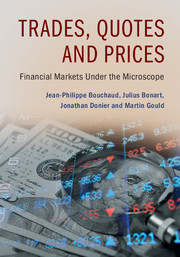Book contents
- Frontmatter
- Dedication
- Contents
- Preface
- Acknowledgements
- PART I HOW AND WHY DO PRICES MOVE?
- PART II LIMIT ORDER BOOKS: INTRODUCTION
- PART III LIMIT ORDER BOOKS: MODELS
- PART IV CLUSTERING AND CORRELATIONS
- PART V PRICE IMPACT
- PART VI MARKET DYNAMICS AT THE MICRO-SCALE
- PART VII ADVERSE SELECTION AND LIQUIDITY PROVISION
- PART VIII MARKET DYNAMICS AT THE MESO-SCALE
- PART IX PRACTICAL CONSEQUENCES
- 21 Optimal Execution
- 22 Market Fairness and Stability
- Appendix
- Index
- References
21 - Optimal Execution
from PART IX - PRACTICAL CONSEQUENCES
Published online by Cambridge University Press: 26 February 2018
- Frontmatter
- Dedication
- Contents
- Preface
- Acknowledgements
- PART I HOW AND WHY DO PRICES MOVE?
- PART II LIMIT ORDER BOOKS: INTRODUCTION
- PART III LIMIT ORDER BOOKS: MODELS
- PART IV CLUSTERING AND CORRELATIONS
- PART V PRICE IMPACT
- PART VI MARKET DYNAMICS AT THE MICRO-SCALE
- PART VII ADVERSE SELECTION AND LIQUIDITY PROVISION
- PART VIII MARKET DYNAMICS AT THE MESO-SCALE
- PART IX PRACTICAL CONSEQUENCES
- 21 Optimal Execution
- 22 Market Fairness and Stability
- Appendix
- Index
- References
Summary
I will remember that I didn't make the world, and it doesn't satisfy my equations.
(Emanuel Derman and Paul Wilmott “The Modeler's Oath”)Optimal execution is a major issue for financial institutions, in which asset managers, hedge funds, derivative desks, and many more seek to minimise the costs of trading. Such costs can consume a substantial fraction of the expected profit of a trading idea, which perhaps explains why most active managers fail to beat passive index investing in the long run. Market friction is especially relevant for high-turnover strategies. Given the importance of these considerations, it is unsurprising that a whole new branch of the financial industry has emerged to address the notion of best execution. Nowadays, many brokerage firms propose trading costs analysis (TCA) and optimised execution solutions for their buy-side clients.
Trading costs are usually classified into two groups:
• Direct trading costs are fees that must be paid to access a given market. These include brokerage fees, direct-access fees, transaction taxes, regulatory fees and liquidity fees. These fees are all relatively straightforward to understand and to measure. As a general rule, direct trading costs are of the order of 0.1–1 basis points and SEC regulatory fees are 0.01 basis points.
• Indirect trading costs arise due to market microstructure effects and due to the dynamics of the supply and demand. In contrast to direct trading costs, indirect trading costs are quite subtle. These costs include the bid–ask spread and impact costs. As we discussed in Chapter 16, the bid–ask spread is a consequence of the information asymmetry between different market participants and is determined endogenously by market dynamics. Spread costs are typically a few basis points in liquid markets, but can vary substantially over time, according to market conditions. Note that the tick size can have a considerable effect on the value of the spread, especially for large-tick stocks.
Impact costs are also a consequence of the bounded availability of liquidity. These costs also arise endogenously, but are deceptive because they are of a statistical nature. Impact is essentially invisible to the naked eye (after a buy trade, the price actually goes down about half the time, and vice-versa), and only appears clearly after careful averaging (see Chapter 12).
Information
- Type
- Chapter
- Information
- Trades, Quotes and PricesFinancial Markets Under the Microscope, pp. 384 - 405Publisher: Cambridge University PressPrint publication year: 2018
